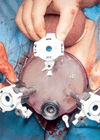Features
Artificial penile pearls: what every Urologist should know!
Penile implants are inert objects placed beneath the skin of the penis through an incision. These are variously referred to as Yakuza beads, pearls, ball bearings, speed bumps, penile marbles, inserts, etc. The term ‘penile implant’ described here should not...
Mesh in urological surgery in the UK – background, reviews and current status
All UK urologists, unless they have been on a 10-year silent retreat, are by now aware of the controversy surrounding surgical use of mesh in general and urological / urogynaecological use of mesh for the surgical treatment of stress urinary...
Immunotherapy in renal cancer
Renal cell carcinoma (RCC) is the sixth most common solid organ cancer in the UK. In 2018, there were 403,262 people diagnosed worldwide with the disease (2.2% of all cancer cases), and it accounted for 175,098 deaths in total (1.8%...
Urinary biomarkers for surveillance of non-muscle invasive bladder cancer
Bladder cancer (BC) is the ninth most common cancer worldwide with a yearly incidence of approximately 430,000 cases. There is a male predominance and it is the seventh most common cancer in men worldwide [1]. Non-muscle invasive bladder cancer (NMIBC)...
Do not hesitate and start using the hashtag, #UroSoMe!
In recent years, the digitisation of scientific information has been astonishing and the use of social networks has been increasing worldwide. Social networks play a fundamental role in the dissemination of information and scientific knowledge in the field of urology...
Inguino-scrotal sarcomas
A sarcoma is a malignant tumour that originates from mesenchymal cells such as adipose tissue, bone, cartilage and smooth muscle. Although these tumours histologically do not originate from the urogenital tract, urologists are often involved in their diagnosis and management...
The expanding indications for ureteroscopy – ad maiora!
The management of urolithiasis is becoming a Herculean task for healthcare providers worldwide. The incidence of stone disease is rising, with predicted lifetime risk of 12% in males and 6% in females [1]. This rise relates to both improving imaging...
An update on erectile dysfunction guidelines and treatment options
Erectile dysfunction is defined as the persistent inability to attain and / or maintain an erection sufficient for sexual performance. Not only does this have a psychosocial impact, it also affects the quality of life of both the patients and...
Getting it Right First Time in urology: the implementation phase
The Getting it Right First Time (GIRFT) programme is the largest and most comprehensive initiative to improve the quality and efficiency of individual clinical services that the NHS has ever instigated. The programme falls under the auspices of NHS Improvement...
Practical surgical management of chronic testicular pain
Chronic testicular pain (CTP) is defined as constant or intermittent, unilateral or bilateral testicular pain of more than three months’ duration, which significantly interferes with the daily activities of the patient prompting medical advice [1-4]. This condition is commonly seen...
Robotic assisted perineal prostatectomy: descriptive technique of the inaugural case in the UK
Robotic surgery has taken full flight in the USA since its start in 2000 [1] and is replacing procedures where open surgical techniques were solely employed. While this technology is met with criticism over the costs, the superiority of robotic...
Penile Mondor’s disease
Mondor’s disease is a rare, self-limiting entity characterised by subcutaneous chord like bands throughout the body. These bands arise due to phlebitis of the subcutaneous vessels. Penile Mondor’s disease (PMD) is an isolated superficial thrombophlebitis of the superficial dorsal vein...













